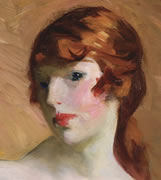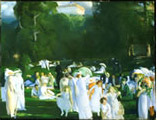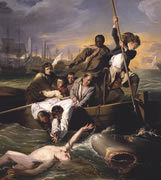Masterpieces of American Art, 1770–1920: From the Detroit Institute of Arts
Baker/Rowland and North Exhibition Galleries
This fall, visitors to the Milwaukee Art Museum have an unprecedented opportunity to celebrate America’s best art and trace the country’s early history and culture through a visually stunning exhibition of painting and sculpture from the period in which American art came into its own. Masterpieces of American Art, 1770–1920: From the Detroit Institute of Arts features more than 90 masterpieces by such great American artists as John Singleton Copley, John Singer Sargent, Gilbert Stuart, Mary Cassatt, Winslow Homer, Frederic Church, William Merritt Chase, Albert Bierstadt, the Peale family and Robert Henri. Organized by the Detroit Institute of Arts from its collection of American art - one of the finest in the nation - the exhibition explores the highlights of our history through almost two centuries. The Milwaukee Art Museum is the only Midwest venue for the exhibition, separate from the Detroit home. The exhibition is sponsored at the Milwaukee Art Museum by M&I Bank and Michael Best & Friedrich LLP. The Museum is reinstalling its own American paintings galleries to coincide with this important exhibition.
“We are delighted to present an exhibition of this breadth that exposes the masterworks of our own nation,” said Museum Director and CEO David Gordon. “Visitors will discover a unique style and definition of beauty created during the earliest years of this country by the greats of American art.”
In its relatively short history, America has produced a vibrant and diverse visual tradition of its own, with fact, pragmatism, awe and a description of place at the heart of its artistic production. European settlers in this new land sought to reinvent notions of government, religion, society and even art, as they forged a uniquely American style.
The exhibition includes such iconic masterpieces as John Singleton Copley’s Watson and the Shark, Frederic Church’s Cotopaxi, and Winslow Homer’s Defiance: Inviting A Shot Before Petersburg. Also featured are great examples by many other figures of American art between 1770 and 1920: still life master Raphaelle Peale; landscapists Thomas Cole and Martin Johnson Heade; sculptor Hiram Powers; genre painters George Caleb Bingham and Eastman Johnson; Philadelphia genius Thomas Eakins; American Impressionists John Singer Sargent, Childe Hassam, and Mary Cassatt; and Ashcan School artists Robert Henri and George Bellows, to name only a few.
One of the strongest of American traits is our urge to define what is American. As American artists sought to create a visual national identity, they looked to both their own dreams and to tutelage from abroad. While American artists alternated between homegrown creativity and international influences, certain characteristics reappear in their art - an adherence to truthful depiction, directness, idealism and a belief in progress. Masterpieces of American Art, 1770–1920 includes some of the best-known works representing the major American art movements and trends of the period, including Hudson River School and American Impressionism. From the faces of a new nation and the Colonial era to American life through the Civil War, global landscapes and the cosmopolitan trends of the later 19th century and early 20th century, the exhibition provides an extraordinary exploration of the exemplary art and artists of our own nation. The story of American art unfolds as the visitor travels through the exhibition.
Museum Reaches Out to New Visitors Through Personal Connection
The Milwaukee Art Museum asked local celebrities to choose their favorite artworks from its new feature exhibition Masterpieces of American Art, 1770–1920: From the Detroit Institute of Arts. The exhibition explores American history through a stunning exhibition of 90 masterworks - some of the finest paintings and sculptures ever produced by American artists.
“The comments from local leaders and entertainers reflect that it is not necessary to have an academic understanding of artwork to enjoy it—instead, it is how we react to a work in a personal way that gives meaning to art,” said David Gordon, Milwaukee Art Museum Director and CEO.
The Museum’s partnership with local celebrities offers visitors a new and unique way to look at and enjoy art. Glenn Adamson, exhibition curator at MAM, explains how people looked at art in the 18th and 19th centuries, "Paintings then were like movies are now, highly public events. Lots of people wanted to see them, and they were discussed and written about widely by critics." Museum officials hope that by sharing these personal interpretations of artworks by local celebrities, a wider variety of visitors are drawn to enjoy the exhibition.
Martin Johnson Heade, Seascape: Sunset
“The power and healing properties of water are celebrated throughout all cultures. It is as though by its very translucent yet powerful nature, our souls are able to relax, resolve and sometimes dissolve into a state of meditation. In this painting, the combination of the ocean and setting of the sun communicates to me a transcendental prayer state .a closeness to an almighty presence.”—Ferne Yangyeitie Caulker, Founder and Artistic/Executive Director, Ko-Thi Dance Company
Frank Weston Benson, My Daughter Elisabeth
“I appreciate the beautiful, yet simple depiction of the young woman, possibly the artist’s daughter. A daughter’s beauty is never lost in a father’s eye! This painting reminds us of that.”—Ricardo Diaz, Executive Director, United Community Center
Robert Henri,The Young Girl
“Henri encouraged the painting of life as it really was and this three-quarter body nude of 1907 was so striking in its realism that Mrs. Henri took an advertisement in the newspapers to tell the world that it was not her that posed for her husband. The model, Edna Smith, is simply gorgeous and we have used her face as one of the emblems of the Museum. To have used the rest of her would still have shocked 97 years later.”—David Gordon, Director and CEO, Milwaukee Art Museum
George Cochran Lambdin, At the Front
“This work exerts strong emotions and illustrates introspection. The soldier’s face shows he is deep in thought and his expression speaks volumes about the devastation of war and its effect on individual soldiers.”—Nannette H. Hegerty, Chief of Police, City of Milwaukee
Frederic Edwin Church, Syria by the Sea
“This landscape portrays a fallen civilization and provides a warning that any society, no matter how strong, can end in ruins.”—Nannette H. Hegerty, Chief of Police, City of Milwaukee
Willard Leroy Metcalf, The White Veil
“Though painted in 1909, the same swirl and drift of snow, among trees like dark exclamation points, is the view from my own window on some winter mornings. It made me wistful and joyful - joyful for the genius of Willard Leroy Metcalf and wistful that there are few places left where one such as I can see the selfsame sight that Metcalf saw one hundred years ago. I’m grateful that one of these places is Wisconsin, and that I am privileged to live here.”—Jacquelyn Mitchard, Author and Writer, Milwaukee Journal Sentinel
Martin Johnson Heade, Seascape: Sunset
“The colors combined with the tranquility of the scene create a soothing atmosphere-a burst of golden tranquility that serves as a reminder of humanity’s link to the sea.”—Gene Mueller, News Director/On-Air Personality, Morning Drive, 94.5 WKTI
Rembrandt Peale, Self-Portrait
“Rembrandt Peale’s Self-Portrait captures something with which every teacher of history wrestles - how to make people of the past alive today. The portrait lives and breathes. You can say to it - "I know you; I’ve met you before.”—Sister Joel Reed, President Emerita, Alverno College
William Sidney Mount, The Banjo Player
“Banjo Bill, not being highly educated, thought he was supposed to be playing at Barnegie Hall.”—Bob Reitman, On-Air Personality, Morning Drive, 94.5 WKTI
Frederic Church, Cotopaxi
“This painting has such majesty! Church captures the reverence for nature and the connection between God and nature by giving the volcano a supernatural primordial feel. One is transported not only to the volcano, but to a place where one could imagine time began. To think that each of the thousands of colors reflected on the canvas have been given to us by nature, but individually mixed and created by the artist is truly awe inspiring.”—Amy Taylor, On-Air Personality, Morning Drive, 94.5 WKTI
Worthington Whittredge, Crow’s Nest
“I love the outdoors and I love camping, so this painting reminds me of places like Devil’s Lake here in Wisconsin. The combination of colors invites me to walk right in and join their journey.”—Scott Walker, County Executive, Milwaukee County
The exhibition has toured to the National Gallery of Ireland, the Phoenix Museum of Art and the San Diego Museum of Art. After the Milwaukee Art Museum, the exhibition travels to the Frick Art and Historical Center in Pittsburgh before returning to Detroit.
- Robert Henri, The Young Girl, c. 1915. Oil on canvas. Collection of the Detroit Institute of Arts, City of Detroit purchase.
- George Bellows, A Day in June, 1913. Oil on canvas. Collection of the Detroit Institute of Arts, Detroit Museum of Art purchase, Lizzie Merrill Palmer Fund.
- Frederic Edwin Church, Cotopaxi, 1862. Oil on canvas. Collection of the Detroit Institute of Arts, Founders Society purchase, Robert H. Tannahill Foundation Fund, Gibbs-Williams Fund, Dexter M. Ferry, Jr. Fund, Merrill Fund, Beatrice W. Rogers Fund, and the Richard A. Manoogian Fund.
- John Singleton Copley, Watson and the Shark, 1777-78. Oil on canvas. Collection of the Detroit Institute of Arts, Founders Society purchase, Dexter M. Ferry, Jr. Fund.




